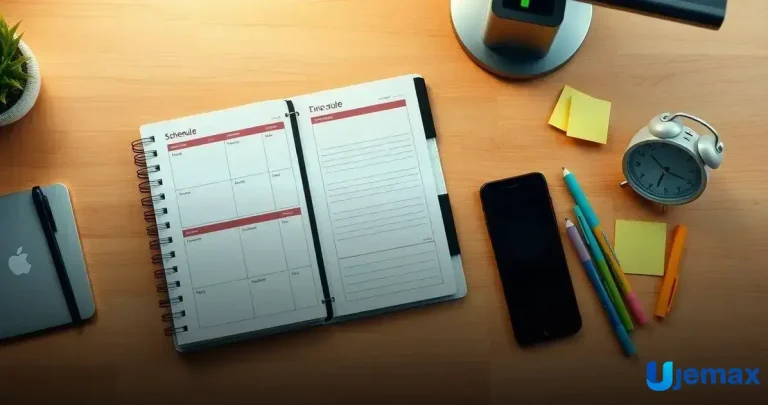ADVERTISEMENT
Time management tricks for work are essential for achieving efficiency in your daily tasks. Balancing multiple responsibilities can be overwhelming without the right strategies. Implementing effective tricks can transform your productivity.
From prioritizing tasks to avoiding common pitfalls, mastering time management is crucial. As you integrate these methods, you’ll find more time in your day.
Keep reading to discover innovative techniques that can help you manage your time better and unlock your full potential!
Understanding Time Management
Understanding time management is about knowing how to use your time wisely. It helps you make choices about what to do first and what can wait. When you manage your time well, you can complete tasks more efficiently and feel less stressed.
ADVERTISEMENT
One important part of time management is setting goals. These goals give you direction and help you stay focused. When you have clear goals, you can use your time on the tasks that matter most to reach them.
Another key aspect is planning your day. By writing a schedule, you can see how your time is spent. This way, you can adjust your plans if something takes longer than expected. Being organized will improve your workday and keep you on track.
Identifying Time Wasters
Identifying time wasters is crucial for improving your productivity. Time wasters are activities or habits that eat up your time without giving much back. Common examples include excessive social media use, aimless internet browsing, and long meetings that could be emails.
Many people are not aware of their time wasters. To spot them, keep a diary of your daily activities for a week. Note how much time you spend on each task. You may find that you are spending more time than you realize on distractions or unimportant tasks.
Once you identify your time wasters, take action to limit them. This might mean setting specific times for checking email or social media. Reducing these distractions can free up more time for your important work, allowing you to achieve your goals more efficiently.
Setting SMART Goals

Setting SMART goals is a powerful way to focus your time and energy. SMART stands for Specific, Measurable, Achievable, Relevant, and Time-bound. Each part of this framework helps you create clear and reachable goals that lead to success in your work.
When your goals are specific, you know exactly what you want to achieve. For example, instead of saying “I want to improve my skills,” a specific goal would be “I want to complete an online course about time management by the end of the month.” Making your goals measurable helps you track your progress and celebrate your achievements.
It is also important that your goals are achievable and relevant. This means they should fit your abilities and align with your long-term objectives. Finally, setting a deadline creates urgency. By having a time frame, you keep yourself accountable and motivated to reach your goal within a set period.
Prioritizing Tasks Effectively
Prioritizing tasks effectively is key to managing your time well. Not all tasks are equally important or urgent. To start, list your tasks and identify which ones have tight deadlines or significant consequences if not completed on time. This helps you focus on what truly matters first.
A popular method for prioritizing is the Eisenhower Matrix. This tool divides tasks into four categories: urgent and important, important but not urgent, urgent but not important, and neither urgent nor important. By placing your tasks in these groups, you can easily see where to focus your efforts and which tasks can be postponed or delegated.
Another effective way to prioritize is to consider the impact of each task. Think about how completing each task will help you reach your goals. This way, you can tackle the most impactful tasks first, leading to greater productivity and a sense of accomplishment in your work.
Employing the Pomodoro Technique
Employing the Pomodoro Technique can help you stay focused and manage your time better. This strategy involves working for 25 minutes at a time, known as a “Pomodoro,” followed by a 5-minute break. During the 25 minutes, focus entirely on your task without any distractions. This method trains your mind to concentrate, making it easier to get more done efficiently.
After completing four Pomodoros, take a longer break of 15 to 30 minutes. This helps refresh your mind and prevents burnout. The breaks allow you to relax and recharge, which improves your overall productivity when you return to work.
One of the great advantages of the Pomodoro Technique is that it encourages discipline and time awareness. You can see how much time you spend on tasks and adjust your schedule based on what you learn. By using this method, you will become better at managing your time and tasks, leading to more efficient workdays.
Dealing with Procrastination

Dealing with procrastination can be challenging, but it’s important to recognize when it happens. It often leads to unnecessary stress and missed deadlines. To tackle procrastination, start by breaking your tasks into smaller, manageable steps. Instead of thinking about the entire project, focus on one small part at a time. This makes it less overwhelming and easier to start.
Setting specific deadlines for these smaller tasks can also help you stay accountable. Use timers to create a sense of urgency, like the Pomodoro Technique mentioned earlier. By committing to work for a set time and then taking breaks, you will find it easier to stay on track and avoid distractions.
Additionally, eliminate distractions from your workspace. This could mean turning off notifications on your phone or using apps that block distracting websites. Creating a dedicated work environment can help you focus better and overcome the urge to procrastinate. With these strategies, you can effectively manage your time and achieve your goals.
Utilizing Digital Tools
Utilizing digital tools is a great way to enhance your time management skills. There are many apps available to help you organize your tasks, set reminders, and track your progress. Tools like to-do list apps or project management software can keep all your tasks in one place, making it easier to see what you need to do.
Another benefit of digital tools is that they can help you communicate better with your team. Collaboration platforms allow you to share files, discuss tasks, and even set deadlines. This keeps everyone on the same page and makes it easier to finish projects on time.
However, it’s important to choose the right tools for your needs. Not every app will work for everyone. Take some time to explore different options and find what fits your style best. With the right digital tools, you can work smarter, stay organized, and keep your day running smoothly.
Creating a Flexible Schedule
Creating a flexible schedule is an effective way to manage your time better. It allows you to adapt your work hours based on your peak productivity times. Start by identifying when you feel most focused and energetic. Some people work best in the morning, while others find their flow in the afternoon or evening. By scheduling challenging tasks during your peak times, you can get more done.
Next, ensure that your schedule includes blocks of time for breaks and unexpected tasks. Life can be unpredictable, so it’s helpful to leave some open time in your calendar. This flexibility allows you to handle emergencies or adjust tasks without feeling stressed. Include short breaks during your work sessions to recharge your mind and keep your productivity high.
Finally, be open to adjusting your schedule as needed. Review your daily and weekly plans regularly to see what is working and what could be improved. If you find certain times are not productive for you, don’t hesitate to change them. A flexible schedule is all about finding what suits you best, which can lead to a more enjoyable and efficient workday.
Evaluating Your Progress

Evaluating your progress is a crucial step in effective time management. Regularly checking in on your goals and tasks helps you see what you have accomplished and where you need to improve. Take time at the end of each week to review what you did well and what challenges you faced. This reflection will help you understand your work habits and adjust your strategies accordingly.
One way to evaluate your progress is by using a checklist or a journal. Writing down your completed tasks gives you a clear picture of what you’ve achieved. You can also note any setbacks you encountered and think about how to overcome them in the future. This record keeps you motivated as you track your growth over time.
Remember that evaluating progress is not just about checking tasks off a list. It’s also about assessing whether you are staying focused on your goals and using your time wisely. Be open to adjusting your plans if you find that certain strategies are not working for you. This adaptability will ensure that you stay on the right path and continue to improve your time management skills.







